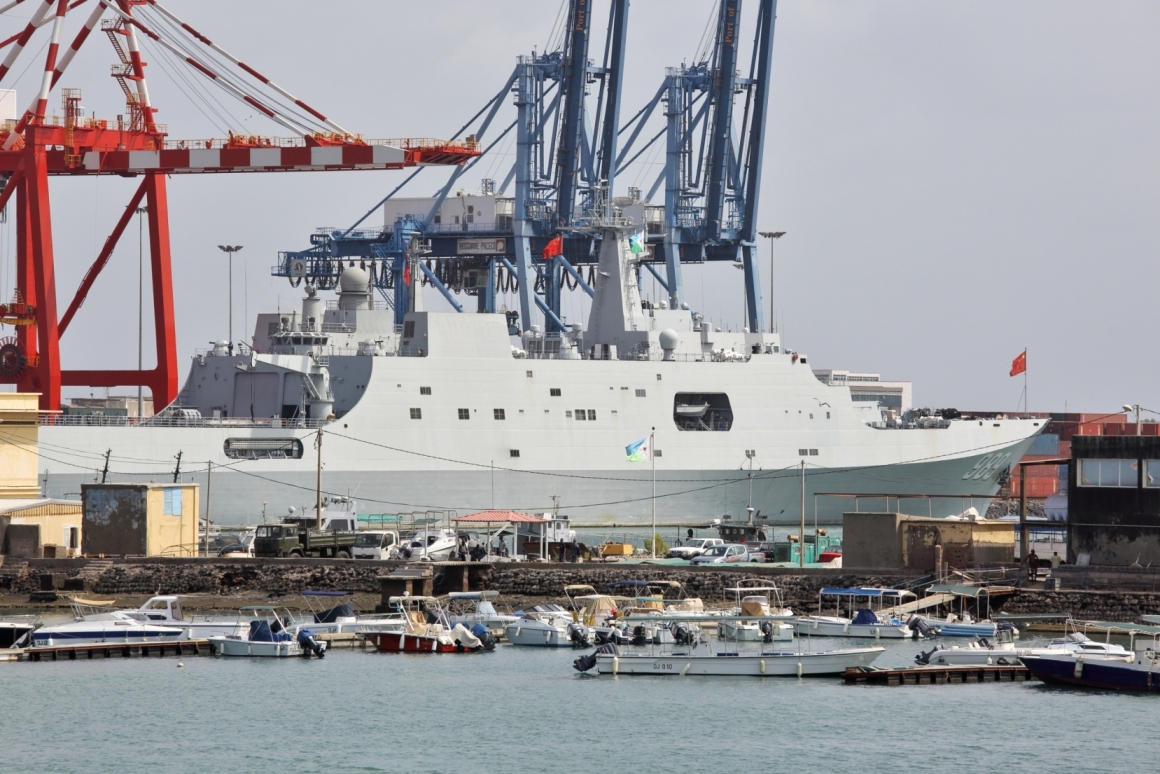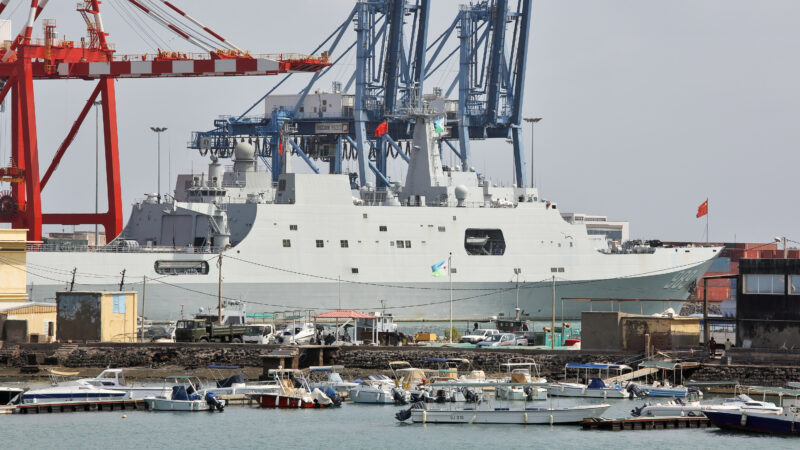Abstract: For several years, the People’s Republic of China has been expanding its political and economic engagement in Africa. As part of the “Belt and Road Initiative” launched in 2013, Chinese entities have been financing and building ports in the Sub-Saharan Africa region. With the opening of the first Chinese military base on foreign territory in the Republic of Djibouti, China is also initiating a new military presence. There are clear benefits of this situation: some African countries are dependent on support for the implementation of infrastructure projects. However, the financing structure provides imbalanced profits to the partners. Through infrastructure projects and credit dependencies, China seems to be seeking to obligate the African Union to a political and economic partnership.
Bottom-line-up-front: Chinese investment projects in sub-Saharan Africa, especially in ports, are economic in nature and fit the status quo of Chinese foreign policy in the region. While the opening of the first foreign military base was certainly a countervailing act to the Western countries, it does not convert the investment projects to a simple projection of power.
Problem statement: What interests does China pursue with its investments in African ports? Is this merely a projection of power in economic disguise? Or does China display a liberal behavioral pattern and actually pursue economic interests?
So what?: The Chinese commitment in Africa should be recognized objectively by Western countries. In the process, military action is to be monitored. Investment packages of the European Union and European Investment Bank (EIB) should be maintained and expanded, benefiting the local African economy. Europe must not allow itself to be left behind politically in the region and should continue to embrace Africa as a strong partner.

Source: shutterstock.com/Vladimir Melnik
China, the New Actor in Africa?
DJIBOUTI – A small state located in western Africa. It is located at the Bab al-Mandab Strait, the southern entrance to the Red Sea. The strait is one of the most critical choke-points for the world’s shipping: 30 % of worldwide commercial shipping passes through here.[1]
In Djibouti City, a large port has developed, financed and built by Chinese entities. According to the Center for Strategic and International Studies (CSIS; Washington D.C.) Africa Program, the Djibouti port is one of 46 port investments of Chinese entities in Sub Saharan Africa (SSA).[2] Chinese companies and investors act as operators, financiers and builders. Operating in this case is defined as ownership and port management. More than half of these port projects are financed by Chinese capital. This also leads to easier access to the projects for Chinese construction companies. Almost all projects are built by Chinese entities.[3]
Chinese investment in SSA is vast and strategic. China is Africa’s largest trading partner, with a trading volume of 200 billion dollars in 2018.[4] The investments are made in ports on the world’s major trading routes, which also have a geopolitical significance.
Moreover, there are rumors of possible Chinese military bases in these ports. In 2017 the first foreign Chinese military base opened at the Port of Djibouti.[5] Djibouti not only borders one of the most important worldwide trade routes of shipping, but also hosts the primary US-American military base in Africa. And not only US-troops are stationed here. The French also maintain their largest oversea base in their former colony Djibouti. Italy joined its NATO partners in 2009 with a small base. Two years later, Japan also established its first overseas base since the end of the second world war.[6]
China is Africa’s largest trading partner, with a trading volume of 200 billion dollars in 2018. The investments are made in ports on the world’s major trading routes, which also have a geopolitical significance.
The opening of this first military base of the People’s Republic of China on foreign territory has attracted much attention. Whereas Western states have been investing abroad for many more years and, especially, showing military presence, the Chinese seem to have only entered the race in the last few years. By comparison, the above-mentioned states do not operate their only foreign military base in Djibouti. The U.S. operates around 600 bases on foreign territory and 100 in U.S. overseas territories.[7] France also operates 11 foreign overseas bases.[8]
All this activity begs the question: What interests does China pursue with its investments? Is this merely a projection of power in economic disguise, following the school of (political) realism? Or does China display a liberal behavioral pattern and actually pursue economic interests?
The Investments and China’s Power Projection
The investments in the ports are part of the new “21st Century Maritime Silk Road” which represents the maritime part of the Chinese “Belt and Road Initiative” (BRI) launched in 2013.[9] The infrastructure program involves over 130 countries and aims to connect China’s economy and politics even more closely with the world.[10]
The question of the increased Chinese interest in Africa seems easy to answer. Africa is the world’s second-fastest growing region. The current population of 1.1 billion people is expected to double by 2050. As a result, the world’s most significant urbanization is taking place there.[11] This will create many opportunities, and thus naturally, Africa is becoming an important economic region with a large sales market.
The question of the increased Chinese interest in Africa seems easy to answer. Africa is the world’s second-fastest growing region.
Furthermore, the continent´s available natural resources are attractive for China. China obtains a considerable share of energy resources from African countries (e.g., a third of China’s oil). The continent has large deposits of metals and rare earths to produce technological goods, and further supplies a large part of cotton for the textile industry.[12]
The Port of Djibouti
A direct military joint use of the “Belt and Road Initiative” has so far always been denied by the official Chinese side.[13] However, BRI’s projects are located at strategically important points, such as the port in Djibouti. The state of Djibouti has signed a Security and Defense Partnership Agreement with the Chinese People’s Liberations Army (PLA) which allows military use. The fact that the base is only described as a PLA “logistics facility” by the Chinese government seems implausible.[14] According to a report of the US-“Congressional Research Service” the site could be equipped with a helicopter hangar and could also accommodate several thousand soldiers.[15] Furthermore, the PLA has also built additional port facilities at the base, and used the facilities to conduct the PLA’s first major live fire exercise on foreign soil.[16]
The PLA’s first foreign military base’s construction was carried out in the spirit of “increasing power.” The fact that this military base was built in Djibouti, an important strategic point where other nations also operate military bases, is a demonstration of power and strength. The military exercise underlines this ambition to impress other nations.
Strategic Strong Points and Dual Use Ports
Besides the possible dual-use of ports on a commercial and military level in Djibouti, it is assumed that there are other projects with a dual-use aim, such as in São Tomé and Príncipe and Namibia in Western Africa.[17]
Abhijit Singh, a senior fellow at the Observer Research Foundation in New Delhi, comments in the Financial Times: “There is an inherent duality in the facilities that China is establishing in foreign ports, which are ostensibly commercial but quickly upgradeable to carry out essential military missions.” Further, he notes: “They are great for the soft projection of hard power.”[18] Especially the possibility of an extension to military use is difficult for other actors to assess. Here, a power projection in economic disguise can be assumed. The projection of hard power is also a means of impressing the other states. It is therefore clear that the projects are an attempt to increase China’s sphere of power.
There is an inherent duality in the facilities that China is establishing in foreign ports, which are ostensibly commercial but quickly upgradeable to carry out essential military missions.
These ports are to form “strategic strongpoints” along the Maritime Silk Road, as demanded by Chinese government institutions. The selected ports fulfill different functions. They are located in geostrategic favorable locations, such as maritime choke-points or Sea Lines of Communications (SLOC).[19] For example, important sea routes could be blocked or controlled.
Moreover, Chinese entities act as operators of several ports which also facilitate access to the surrounding infrastructure. Especially in locations where the ports are operated by China, military use of the port facilities cannot be excluded, either through indirect support of naval ships or direct support, if ships of the Chinese People’s Liberation Army Navy (PLAN) can dock at the port.[20]
Dual-use ports at strategic points clearly reveal China’s ambition to expand its positions of power. The ports are located at the most important SLOCs in world trade. China is implementing investment projects across the continent under the conscious observation of the other states to demonstrate its power.
However, infrastructure projects stabilize governments and the economy locally and thus bring benefits for the host states.[21]
China’s Military Activities in Africa
China has expanded its naval activities in Sub-Saharan Africa. However, can this already be regarded as power projection? Until now, China has always been very cautious and has rather tried to “keep a low profile in the military and security domain”.[22] The PLAN, Asia’s largest navy, is currently renewing its fleet and operates mainly in the western pacific.
Since 2009, China has also participated in a counter-piracy mission under the United Nations’ authority (UN) in the Gulf of Aden.[23] The PLAN has helped escort merchant ships and shipments of the UN World Food Program. These missions have enabled China to increase its maritime presence in the Horn of Africa and to carry out other tasks such as humanitarian relief or emergency evacuations.[24]
Chinese companies are implementing many infrastructure projects in connection with BRI and the Maritime Silk Road, involving almost 300,000 Chinese workers. Through several attacks on workers and property in various African countries, the Chinese government has become more concerned about the safety of Chinese nationals.[25] As a result, emergency evacuations are becoming increasingly important.[26]
Furthermore, there were several visits of the PLAN anti-piracy escort task forces to West African ports, among others in Ghana and Nigeria. Joint military exercises were carried out with the countries, and further military agreements on weapons acquisition and military cooperation were concluded. In 2018, the PLAN hospital ship “Peace Ark” also visited some East African coastal countries to provide free medical and humanitarian services to the local population.[27]
The military presence in the Sub-Saharan region is not a sudden one. Through the UN missions, the PLAN has been in the region for some time. Both the hospital ship’s journey and the rescue of Chinese citizens are humanitarian in nature. Some of the investments along the Maritime Silk Road have a military character or at least a twofold motivation. Military actions, the dual-use ports and the new military base are political actions and largely strategically and power-politically motivated. They serve the goal of increasing power.
However, the BRI is a major infrastructure program which involves high costs and risks for the Chinese state. The Chinese presence through the infrastructure projects and their workers as well as joint military exercises and actions of a humanitarian nature also have liberal idealistic features. These features describe that China, besides the actions of power projection, tries to place its interests on an ideal level in the SSA states in order to achieve an ideal and social relationship with the states. According to the idealistic liberalism harmony and cooperation can be expected when ideals and social identity are similar. Cooperation thus grows from within and is not purely due to the externally imposed power projection. The presence seeks to adjust political consensus to maintain cooperation.
Sino-African Economic Relations
China’s closer economic cooperation with Africa began in 2001 with the “going out” policy launched by Chinese authorities. The “going out” policy outlined a strategy to increase Chinese participation in the international competitive market, mainly through direct investment and the establishment of Chinese companies abroad.[28] After the financial crisis in Europe, China became Africa’s largest trading partner with an overall trading value of USD 180 Billion today.[29]
Chinese Foreign Direct Investment (FDI) in Africa has grown steadily since 2003, totaling USD 5.4 billion in 2018.[30] For reference and later analysis: the gross annual revenues of Chinese companies in engineering and construction projects in Africa amounted to almost USD 50 billion in 2018.[31]
With the BRI described above, Chinese involvement in Africa has been further increased. The infrastructure projects supported in this context include the investments in ports.[32] However, most ports do not have to be considered as a security risk and are purely commercial in nature. In 27 cases, Chinese entities have acted as investors. Furthermore, Chinese companies have carried out the construction of 41 ports. In only eleven ports, a port ownership or operator position is to be established, allowing control of the port.[33] This suggests a more liberal and economically motivated behavior.
90% of Africa’s exports and imports pass through its ports. In their Maritime Strategy 2050, the African Union itself has described the weak port and domestic transport infrastructure, while recognizing its potential.[34]
In their Maritime Strategy 2050, the African Union itself has described the weak port and domestic transport infrastructure, while recognizing its potential.
The closure of the infrastructure gap is a prerequisite for long-term successful participation in the global trading market. To realize this task, African countries are dependent on foreign investment.[35] The African market’s potential and the possibility of favorable investment opportunities have been recognized by the Chinese. With the BRI, China wants to expand its economic supremacy in the world. Of course, the African states also benefit from the infrastructure projects; otherwise, they would probably not have agreed to projects.
Nevertheless, the investment structure makes it questionable whether both parties will benefit at the same time and to the same extent. Such discrimination is officially denied. China’s President Xi stated on the opening ceremony of the Second Belt and Road Forum for International Cooperation in Beijing: “The joint pursuit of the Belt and Road Initiative (BRI) aims to enhance connectivity and practical cooperation. It is about jointly meeting various challenges and risks confronting mankind and delivering win-win outcomes and common development”.[36]
There is no doubt that African countries also benefit, as they are aware of the infrastructure gaps. Most projects without foreign participation in their implementation do not get beyond financing. Governments lack planning know-how, including technical and financial risk assessment. There are communication difficulties between responsible agencies. Additionally, there is also a lack of financing guarantees from the state. Due to weak capabilities in planning, managing, and execution of large projects, they are not delivered as planned. Consequently, very few investments meet investors’ risk-return expectations.[37] This initially discourages direct investment donors.
Looking more closely at the figures, this investment ecosystem could explain why China is more of a service provider and lender than a major investor. Infrastructure projects such as ports are based on debt-financed packages from state to state where contracts are awarded directly to Chinese companies without public tendering. Therefore, domestic companies are not commissioned with the projects. As a result, African economies cannot benefit directly, and debt may not be sustainable.[38] To illustrate: China is financing one in five infrastructure projects and building one in three.[39]
Other examples relating to the domestic connection of ports also show how infrastructure projects place a burden on African countries. Also, the Addis Ababa-Djibouti Railway for the connection Ethiopia to the port of Djibouti ended up costing Ethiopia a quarter of the annual GDP. The financial dependence of Africa on China can no longer be denied. In 2015 two thirds of African loans came from Chinese lenders.[40] The African states are well aware of this dependence but see no other way to implement such projects. Djibouti’s foreign affairs minister commented in the Washington Post: “Yes, our debt to China is 71% of our GDP, but we needed that infrastructure.”[41] It accepts the dependence and implementation by foreign companies to realize projects as quickly as possible. But the implementation of infrastructure projects by Chinese companies means that the local economy can benefit less. Hence, it is difficult for states to build up a sustainable economic sector that can successfully implement infrastructure projects on its own in the long term. Shaw confirms this in the PWC report, stating that investors in Sub-Saharan ports are more interested in a quick return on investment than in building the local economy in the long run.[42]
As Africa’s largest trading partner, China has a great interest in avoiding high logistics costs at ports. Poor reliability and low economies of scale in trade volumes also impact Chinese and African trade growth.
Economic Interdependence
Chinese investments in ports are made out of economic interest, as the potential of the SSA region has been recognized. It remains questionable how sensitive the relationship and its influence on the economic development of the single actor is. To what extent are the two actors economically linked and dependent on each other?
The AU is dependent on foreign financing from China. So, it also depends on a successful Chinese economy, which is in turn bolstered by infrastructure programs like the BRI. China remains Africa’s largest trading partner. In any case, a unilateral interdependence is evident.
On the other hand, it is certainly clear that China, as a global economic powerhouse, does not rely solely on good economic development in Africa to support its economy. However, it is dependent on a politically and economically stable region, not only out of concerns for the supply of resources and goods for further processing. Rather, the repayment of loans also makes up a large part of the domestic GDP of several states, so repayment of the loans and a positive return on investment can only be achieved if the SSA region also develops positively in economic terms. Moreover, the SSA region is to be expanded as a market for Chinese products.
The win-win situation is not equally weighted on both sides. However, completely one-sided profit by China is rejected, and a slight two-sided interdependence can be seen.
Self-interest or reciprocity in gains?
Closer examination of Chinese and African interests in China’s SSA port investment reviews whether the interests are merely a projection of power in economic disguise or display a liberal behavioral pattern and actually pursuing economic interests. With the investigation of the military activities and the example of Port Djibouti, it cannot be denied that China shows military interest in the region. In the long run it aims to establish itself as a strong marine nation.
At present, military use is a future option but is not being pursued too actively. Until the military base’s opening, China had not been militarily active in the SSA region and was only part of international missions. Most of the port projects were created without the possibility of dual-use and are of a purely commercial nature.
Due to the form of financing and the high level of involvement of Chinese companies, China naturally acts with self-interest. In the long term, the actors involved will be economically and politically bound to China. Cooperation and economic dependence result in interdependent relationships in the sense of a liberal pattern of behavior.
The hypothesis of a power projection in economic disguise is refuted by the economically motivated interests which suggest a liberal pattern of behavior. Thus, the investments are mainly motivated by economic interests. The realization of naval ambitions from a security policy perspective is nevertheless gladly accepted by the Chinese side. Under the current rather commercial approach, Chinese influence is certainly spreading. In the long run, a military influence may also develop due to the infrastructure built, the dominating influence and the good relationship to the host states. With the investments and military activities such as joint exercises, China also strengthens its relationships with these host states, increasing its influence in the world. For the moment Chinese actors have recognized the region’s potential and are addressing the infrastructure gap solution in demand.
Lennart Schlegel studies Economics with a minor in Political Science at the University of Bonn. The Article is based on a term paper which was written in a seminar on “Maritime Security and Strategy”. Currently he is attending his Erasmus stay at KU Leuven, Belgium.
[1] Katarina Manson, “Jostling for Djibouti”, Financial Times, April 01, 2016, accessed 15 October, 2020, https://www.ft.com/content/8c33eefc-f6c1-11e5-803c-d27c7117d132.
[2] Judd Devermont, Amelia Cheatham and Catherine Chiang, Assessing the Risks of Chinese Investments in Sub-Saharan African Ports (Center for Strategic and International Studies, 2019), 1, https://csiswebsite-prod.s3.amazonaws.com/s3fs-public/publication/190604_AfricaPorts.pdf.
[3] Ibid., 5.
[4] Chiponda Chimbelu, “Making Chinese investment in African ports work despite risks”,
Deutsche Welle, June 21, 2019, accessed October 13, 2020, https://p.dw.com/p/3KmXo.
[5] Conor Kennedy, “Strategic Strong Points and Chinese Naval Strategy”, China Brief 19, no. 6 (2019), https://jamestown.org/program/strategic-strong-points-and-chinese-naval-strategy/.
[6] Youssef Igrouane, “Djibouti: A Busy Hub of Foreign Military Bases on the Horn of Africa”, Inside Arabia, 11 July, 2019, accessed March 03, 2021, https://insidearabia.com/djibouti-a-busy-hub-of-foreign-military-bases-on-the-horn-of-africa/.
[7] Alexandre de Robaulx de Beaurieux, “Militärstützpunkte der USA”, Swiss Institute for Peace and Energy Research, January 2017, accessed March 03, 2021,
https://www.siper.ch/assets/uploads/files/diagrams/SIPER%20Grafik%20Militaerstuetzpunkte%20der%20USA.pdf.
[8] Alexandre de Robaulx de Beaurieux, “Militärstützpunkte von Frankreich”, Swiss Institute for Peace and Energy Research, November 2016, accessed March 03, 2021,
https://www.siper.ch/assets/uploads/files/diagrams/SIPER%20Grafik%20Militaerstuetzpunkte%20von%20Frankreich.pdf.
[9] Devermont 2019, Assessing the Risks of Chinese Investments in Sub-Saharan African Ports, 1.
[10] Daniel R. Russel and Blake H. Berger, Weaponizing the Belt and Road Initiative (Asia Society Policy Institute, 2020), 7, https://asiasociety.org/sites/default/files/2020-09/Weaponizing%5C%20the%5C%20Belt%5C%20and%5C%20Road%5C%20Initiative_0.pdf.
[11] Wade Shepard, “What China Is Really Up To In Africa”, Forbes Magazine, 03 October, 2019, accessed October 21, 2020, https://www.forbes.com/sites/wadeshepard/2019/10/03/what-china-is-really-up-to-in-africa/?sh=42c90e735930.
[12] Ibid.
[13] Russel, Weaponizing the Belt and Road Initiative, 8.
[14] Ibid., 23.
[15] Lauren Ploch Blanchard and Sarah R. Collins, Chinas Engagement in Djibouti, Congressional Report Service IF 11304 (United States Government, 2019), 2,
https://crsreports.congress.gov/product/pdf/IF/IF11304.
[16] Paul Nantulya, Chinese Hard Power Supports Its Growing Strategic Interests in Africa (Africa Center for Strategic Studies, 2019), accessed October 16, 2020, https://africacenter.org/spotlight/chinese- hardpower-supports-its-growing-strategic-interests-in-africa/.
[17] James Kynge and Chris Campbell, “How China rules the waves”, Financial Times, January 12, 2017, accessed October 16, 2020, https://ig.ft.com/sites/china-ports/.
[18] Ibid.
[19] Russel, Weaponizing the Belt and Road Initiative, 23.
[20] Ibid.
[21] Kennedy, “Strategic Strong Points and Chinese Naval Strategy”, 3.
[22] Frans-Paul van der Putten and Minke Meijnders, China, Europe and the Maritime Silk Road, Clingendael report (Netherlands Institute of International Relations, 2015), 6, https://www.clingendael.org/sites/default/files/2016-02/China_Maritime_Silk_Road.pdf.
[23] Gisela Grieger, China’s growing role as a security actor in Africa, European Parliamentary Research Service PE 642.232 (European Parliament, 2019), 11, https://www.europarl.europa.eu/RegData/etudes/BRIE/2019/642232/EPRS_BRI(2019)642232_EN.pdf.
[24] Putten, China, Europe and the Maritime Silk Road, 21.
[25] Nantulya, Chinese Hard Power Supports Its Growing Strategic Interests in Africa.
[26] Putten, China, Europe and the Maritime Silk Road, 21.
[27] Nantulya, Chinese Hard Power Supports Its Growing Strategic Interests in Africa.
[28] Thomas Vendryes, “Chinese firms going out: An economic dynamic with political significance”, China Perspectives, 2012, 67,
http://journals.openedition.org/chinaperspectives/5822.
[29] Johns Hopkins University China Africa Research Initiative, “China-Africa Trade”, 2020, Johns Hopkins University, http://www.sais-cari.org/data-china-africa-trade.
[30] Johns Hopkins University China Africa Research Initiative, “Chinese Investment in Africa”, 2020, Johns Hopkins University, accessed October 21, 2020, http://www.sais- cari.org/chinese-investment- in-africa.
[31] Johns Hopkins University China Africa Research Initiative, “Chinese Contracts in Africa”, 2020, Johns Hopkins University, accessed October 21, 2020, http://www.sais-cari.org/data-chinese-contracts-in-africa.
[32] Grieger, China’s growing role as a security actor in Africa, 2.
[33] Devermont, Assessing the Risks of Chinese Investments in Sub-Saharan African Ports, 4.
[34] AU African Union, 2050 Africa’s Integrated Maritime Strategy (2012), 8, 28, https://cggrps.com/wp-content/uploads/2050-AIM-Strategy_EN.pdf.
[35] Kannan Lakmeeharan, Qaizer Manji and Ronald Nyairo, Solving Africa’s infrastructure paradox (McKinsey & Company, 2020), accessed October 21, 2020, https://www.mckinsey.com/business-functions/operations/our-insights/solving-africas-infrastructure-paradox.
[36] Jinping Xi, “Working together to deliver a brighter future for Belt and Road cooperation”, NPC Magazine,no. 2 (2019), 8,
http://www.npc.gov.cn/npc/c16175/201909/58541b5bd2fc416481919ec3d259a1e3/files/3aa8b87afc19439fb8a0550e50d0cb22.pdf.
[37] Lakmeeharan, Solving Africa’s infrastructure paradox.
[38] Grieger, China’s growing role as a security actor in Africa, 3.
[39] Hannah Marais and Jean-Pierre Labuschagne, “If you want to prosper, consider building roads: China’s role in African infrastructure and capital projects”, Deloitte Insights, 2019, 3, https://www2.deloitte.com/us/en/insights/industry/public-sector/china-investment-africa-infrastructure-development.html.
[40] Shepard, “What China Is Really Up To In Africa”.
[41] Max Bearak, “In strategic Djibouti, a microcosm of China’s growing foothold in Africa”, The Washington Post, December 30, 2019, accessed October 13, 2020, https://www.washingtonpost.com/world/africa/in-strategic-djibouti-a-microcosm-of-chinas-growing-foothold-in-africa/2019/12/29/a6e664ea-beab-11e9-a8b0-7ed8a0d5dc5d_story.html.
[42] Andrew Shaw, Manish R. Sharma and Julian Smith, Strengthening Africas gateways to trade (PricewaterhouseCoopers, 2018), 4, https://www.pwc.co.za/en/assets/pdf/strengthening- africasgateways-to-trade.pdf.






